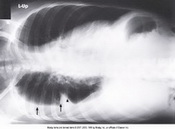IR Size: 14x17 LW chest bucky (CW for hypersthenic pts)
SID: 72''
• Pt faces bucky with back of hands placed: low on hips
• Shoulders relaxed & rotated: forward (Draws scapulae from lung field)
• (Pendulous breasts must be: pulled upward & laterally & pt tightly against bucky)
• (AP may be used if pt can't: be prone-60-72"")
• _|_ to T7 (inferior aspect of scapula)
•
•
• No rotation-sternal ends of clavicles equidistant from vertebrae)
• Good inspiration 10 posterior ribs above diaphragm
• Penetration of the mediastinum properly exposed
• Entire lung field
• Scapulae outside lung fields

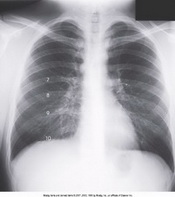
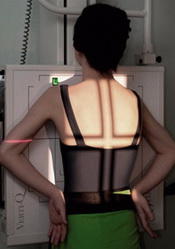
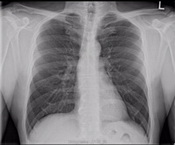
IR Size: 14x17 LW chest bucky (LW or CW for hypersthenic pts)
SID: 72''
• pt Lateral-Left lat to show: heart, aorta, left-sides pulmonary lesions
• Right lat shows: right-sided pulmonary lesions
• MSP: vertical & parallel
• Arms raised: above head; grasp elbows; shoulder rests against bucky (IV pole can be used as high as possible)
• _|_ to T7 (inferior aspect of scapula) @ MCP
•
•
• Interlobar fissures, differentiate lobes, localize pulmonary lesions
• No rotation-superimposed posterior ribs
• NR Sternum
• Hilum in center of radiograph
• Adequate penetration of lung field & heart
• Arms & soft tissue out of lung field
• Costophrenic angles & lung bases

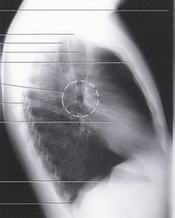
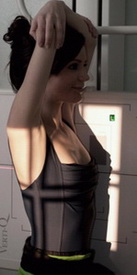
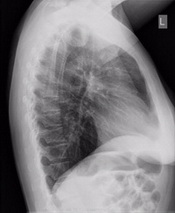
IR Size: 14x17 in chest bucky
SID: 72''
• RAO-Rt palm: on hip, Lt palm on bucky: LAO opposite)
• Body rotated: 45° for routine, 55°-60° cardiac series (shows heart & greater blood vessels, projects heart from spine, BaSO4 may be used to outline posterior heart & aorta)
• (AP Oblique's may be used if: pt can't be prone, investigating specific lesions, or for more heart distortion)(remember RAO=LPO…LAO=RPO)(LPO-Rt palm on hip, Lt palm on head: RPO opposite)
• _|_ to T7 & centered on side up
•
•
• RAO(/LPO)=Lt lung, LAO(/RPO)=Rt lung




IR Size: See PA Oblique
SID: 72''
•
•
•
•




IR Size: See PA info
SID: 72''
•
•
•
•




IR Size: 14x17 in chest bucky
SID: 72''
• pt erect facing tube standing: 1' in front of chest bucky
• pt leans: back toward & rests shoulder against bucky
• (Oblique Lordotic positions (RPO/LPO) body rotated:30° toward being examined)
• _|_ to mid-sternum
• if pt can't do extreme lordosis CR 15°-20° cephalad
•
• Lung apices & interlobar effusions
• TOF 3"" superior to shoulders
• Clavicles superior to lung apices
• Sternal ends of clavicles equidistant from vertebrae
• Apices & lungs in entirety



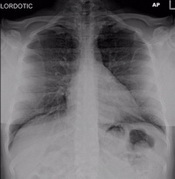
IR Size:
SID:
•
• _|_ to long axis of stermum & IR about 3"" below the jugular notch
•
•
• No motion with well defined diaphragmatic domes and lung fields
• Entire lung field
• Ribs and thoracic intervertebral disk spaces faintly visible through heart shadow
• No rotation-sternal ends of clavicles equidistant from vertebrae)
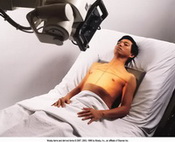
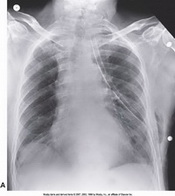


IR Size: 14x17 LW
SID: 72""
• Place the patient in a lateral decubitus position
• Small amount of fluid in the pleural cavity is usually best shown with the patient lying on the affected side. Small amount of free air in the pleural cavity is generally best shown with the patient lying on the unaffected side
• Allow patient to remain in the position for 5 minutes before the exposure. This allows fluid to settle and air to rise
• If patient is lying on the affected side, elevate the body 2"" to 3"" on a suitable platform or a firm pad.
• Extend arms above head, & adjust thorax in TLP
• _|_ IR 3"" below the jugular notch for AP and T7 for PA
•
•
• No rotation of the patient from a true frontal posi tion, as evidenced by the clavicles being equidistant from the spine
• Affected side in its entirety
• Apices
• Proper identification visible to indicate that decubitus was performed
• Patient's arms not visible in the field of interest

